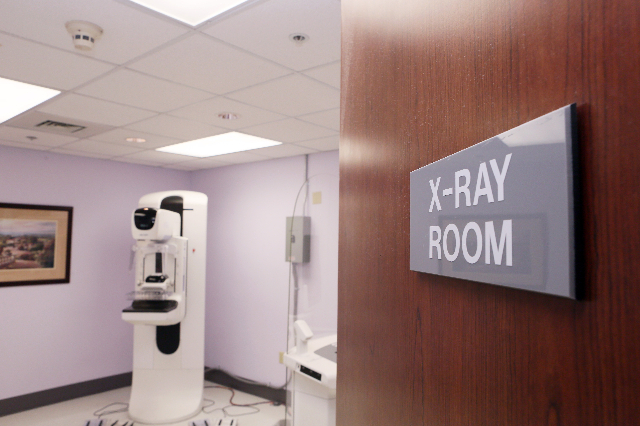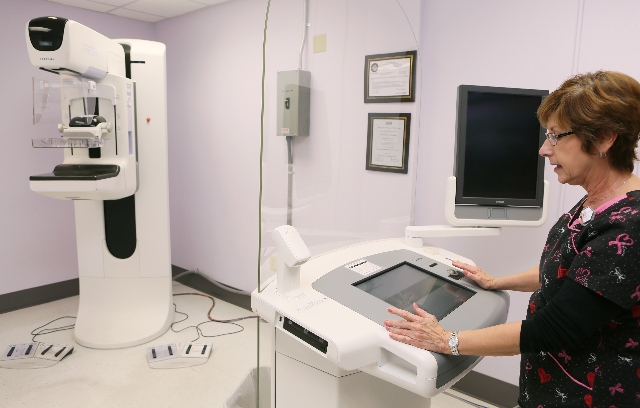3-D technology can reduce false alarms in mammograms, doctors say
The latest generation of mammography — offering 3-D imaging — reduces false alarms, Southern Nevada radiologists say, meaning fewer women will be called back for additional tests because of suspicious findings.
An abnormal mammogram can trigger a course of events that begins with the patient being told there's something amiss. Additional diagnostic work including a clinical mammography, ultrasound or biopsy is required before doctors can make a diagnosis of breast cancer.
Women can go through that process and learn the abnormality was not cancer, an obvious relief, but the emotional turmoil can persist.
Recalls after suspicious mammograms should be performed cautiously, and information and support provided to reduce the psychosocial consequences, according to a study published in August in Cancer Epidemiology, Biomarkers & Prevention, a journal of the American Association of Cancer Research.
Technological advancements mean doctors and patients are more informed.
"Now we can see very, very small things in the breasts," Dr. David Steinberg, Steinberg Diagnostic Medical Imaging in Las Vegas, said of 3-D mammograms. "We can look in detail, in very thin sections, and see distortions in the breast tissue that you wouldn't see, that would be obscured in a 2-D mammogram."
The goal in cancer care is to find tumors at an early stage and attack them in the most effective fashion, possibly with less treatment. Improved detection reduces false-positive results, when a scan shows an abnormal area that looks like cancer but turns out to be normal.
Kim Savage, the practice manager at Women's Health Associates of Southern Nevada, remembers the concerns she had after a mammogram required additional diagnostic tests. Being employed in health care helped her manage the stress and anxiety without any long-term effects from those weeks of uncertainty.
For Savage, the false positive had another effect.
"I'll tell you what it did make me do: Commit to never missing another annual mammogram," Savage said. "I'm religious about getting a mammogram every year."
Doctors advise women to try to manage their stress when something suspicious turns up during their mammograms, especially women receiving their first screening. For someone who has had a false-positive result, the stress and anxiety is real and can last long after cancer has been ruled out. Women are obviously relieved they don't have cancer, but they still need to be treated sensitively.
Emotional vs. physical pain
The restoration of emotional well-being isn't as simple as treating a headache.
You can take a painkiller to get rid of a headache, and the pain eventually is forgotten. Emotional pain doesn't relieve as quickly or easily.
Consistency of the care team can help deliver better results.
"When I talk to my patients, I talk about the importance of going back to the same location and having the same tests done," said Dr. Staci McHale of New Beginnings OB-GYN. "Comparisons of images from previous years can help lower the risk of a false positive."
Fear of women dying for lack of early interventions has led to increasingly aggressive breast cancer treatments for the past several decades.
A few experts have advocated for more use of active surveillance, monitoring suspicious results closely at regular intervals. Active surveillance often is employed for prostate cancer, which can grow very slowly meaning some men might never need cancer treatment.
Most experts say the medical data is insufficient to know whether active surveillance in breast cancer is safe.
On Tuesday, the American Cancer Society recommended that women with an average risk of breast cancer start having mammograms at 45 and continue once a year until 54. After age 55, those women should have a mammogram every other year for as long as they are healthy and expected to live another 10 years, the group said.
Dr. Donna Miller, an obstetrician-gynecologist with Essential Women's Health Associates in Las Vegas, emphasized that the group's new guidelines only apply to patients with an average risk. Women with a family history or genetic risk factors still should be tested more regularly.
"You can't apply these guidelines to every single person," Miller said.
Computer algorithm gives 3-D image
Breasts contain fat, which appears black on a scan, and glandular tissue, which looks white, but cancers also are white for the most part.
"Imagine trying to see a polar bear eating vanilla ice cream in a snowstorm," said Steinberg, managing partner of Steinberg Diagnostic Medical Imaging. "You're trying to differentiate the ice cream from the polar bear from the snowstorm, and it's not so easy."
Known as digital breast tomosynthesis, 3-D mammography soon will become the standard of care in breast screening, radiologists say.
"We can in effect slice through that breast tissue 1 millimeter at a time," added Dr. Randal Shelin, president of Desert Radiologists. "A complex computer algorithm gives us a 3-D image of the breast."
The first generation of mammography, analog or traditional film mammograms, has been overtaken by digital mammography over the past 15 years. Now analog is only performed in remote areas where newer technology always takes longer to arrive.
In addition to Desert Radiologists and Steinberg's clinics, Sunrise Hospital has the 3-D technology.
Digital breast tomosynthesis was approved by the Food and Drug Administration in February 2011, but in Southern Nevada, only Medicare and Teachers Health Trust cover the procedure.
Brenda Kelley, chief executive officer of Teachers Health Trust said the reduction of false positives was a key factor in the decision to make 3-D mammography a covered benefit.
Shelin of Desert Radiologists wanted to make clear that 2-D mammography is still a tremendous tool, but he sees digital breast tomosynthesis overtaking 2-D just like analog mammography was supplanted.
"Patients need to talk to their providers," Shelin said. "It can be confusing for women when they look at the literature and medical data, but they need to look at their risk factors.
"They need to be aware of the risks."
Contact Steven Moore at smoore@reviewjournal.com or 702-380-4563.

























